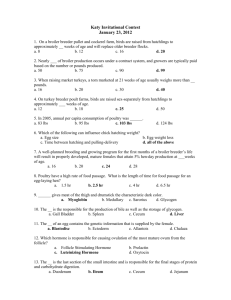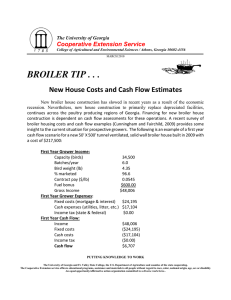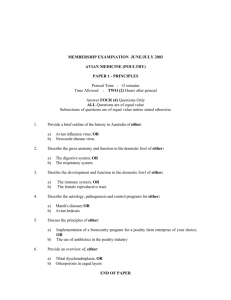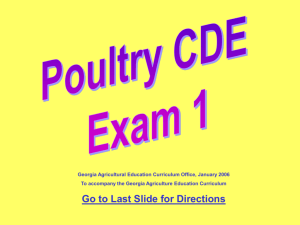Document 11133437
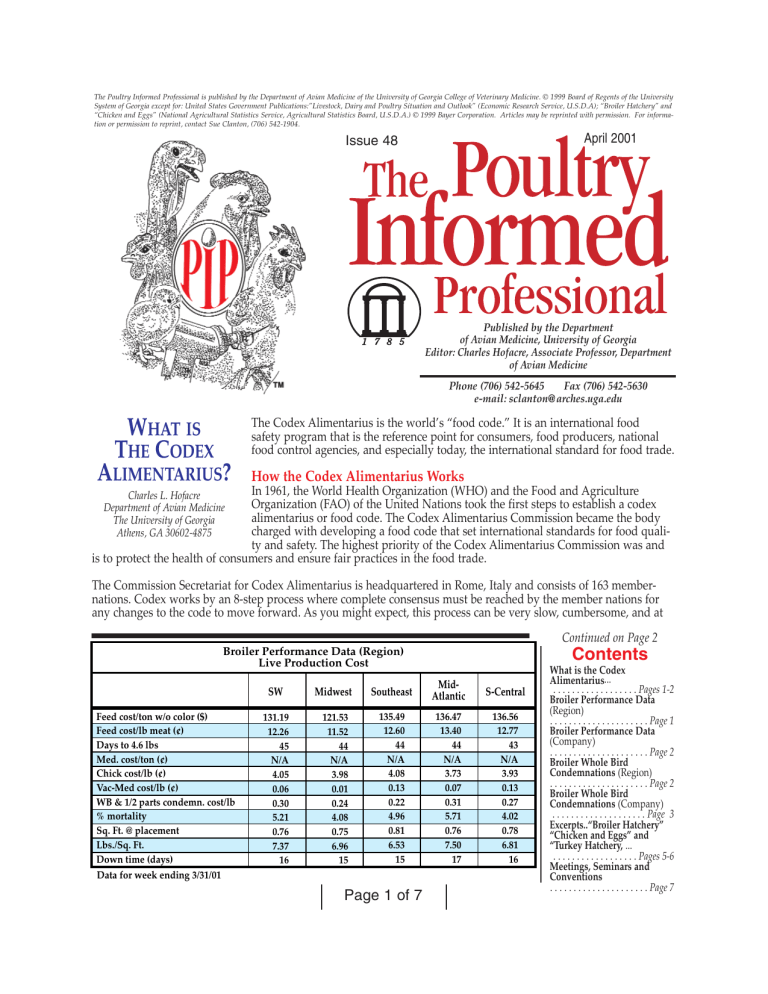
The Poultry Informed Professional is published by the Department of Avian Medicine of the University of Georgia College of Veterinary Medicine. © 1999 Board of Regents of the University
System of Georgia except for: United States Government Publications:”Livestock, Dairy and Poultry Situation and Outlook” (Economic Research Service, U.S.D.A); “Broiler Hatchery” and
“Chicken and Eggs” (National Agricultural Statistics Service, Agricultural Statistics Board, U.S.D.A.) © 1999 Bayer Corporation. Articles may be reprinted with permission. For information or permission to reprint, contact Sue Clanton, (706) 542-1904.
Issue 48 April 2001
Published by the Department of Avian Medicine, University of Georgia
Editor: Charles Hofacre, Associate Professor, Department of Avian Medicine
Phone (706) 542-5645 Fax (706) 542-5630 e-mail: sclanton@arches.uga.edu
W
HAT IS
T
HE
C
ODEX
The Codex Alimentarius is the world’s “food code.” It is an international food safety program that is the reference point for consumers, food producers, national food control agencies, and especially today, the international standard for food trade.
A
LIMENTARIUS
?
How the Codex Alimentarius Works
Charles L. Hofacre
Department of Avian Medicine
The University of Georgia
Athens, GA 30602-4875
In 1961, the World Health Organization (WHO) and the Food and Agriculture
Organization (FAO) of the United Nations took the first steps to establish a codex alimentarius or food code. The Codex Alimentarius Commission became the body charged with developing a food code that set international standards for food quality and safety. The highest priority of the Codex Alimentarius Commission was and is to protect the health of consumers and ensure fair practices in the food trade.
The Commission Secretariat for Codex Alimentarius is headquartered in Rome, Italy and consists of 163 membernations. Codex works by an 8-step process where complete consensus must be reached by the member nations for any changes to the code to move forward. As you might expect, this process can be very slow, cumbersome, and at
Broiler Performance Data (Region)
Live Production Cost
Feed cost/ton w/o color ($)
Feed cost/lb meat (¢)
Days to 4.6 lbs
Med. cost/ton (¢)
Chick cost/lb (¢)
Vac-Med cost/lb (¢)
WB & 1/2 parts condemn. cost/lb
% mortality
Sq. Ft. @ placement
Lbs./Sq. Ft.
Down time (days)
Data for week ending 3/31/01
SW
131.19
12.26
45
N/A
4.05
0.06
0.30
5.21
0.76
7.37
16
Midwest Southeast
121.53
11.52
44
N/A
3.98
0.01
0.24
4.08
0.75
6.96
15
135.49
12.60
44
N/A
4.08
0.13
0.22
4.96
0.81
6.53
15
Page 1 of 7
Mid-
Atlantic
136.47
13.40
44
N/A
3.73
0.07
0.31
5.71
0.76
7.50
17
S-Central
136.56
12.77
43
N/A
3.93
0.13
0.27
4.02
0.78
6.81
16
Continued on Page 2
Contents
What is the Codex
Alimentarius ...
. . . . . . . . . . . . . . . . . . Pages 1-2
Broiler Performance Data
(Region)
. . . . . . . . . . . . . . . . . . . . . Page 1
Broiler Performance Data
(Company)
. . . . . . . . . . . . . . . . . . . . . Page 2
Broiler Whole Bird
Condemnations (Region)
. . . . . . . . . . . . . . . . . . . . . Page 2
Broiler Whole Bird
Condemnations (Company)
. . . . . . . . . . . . . . . . . . . . Page 3
Excerpts..“Broiler Hatchery”
“Chicken and Eggs” and
“Turkey Hatchery, ...
. . . . . . . . . . . . . . . . . . Pages 5-6
Meetings, Seminars and
Conventions
. . . . . . . . . . . . . . . . . . . . . Page 7
times, frustrating. However, once consensus is reached and the new standard is accepted by the commission, the member nations are free to use that standard under WTO rules and treaty obligations.
The World Trade Organization
As international trade of food grew, a primary concern for many countries became the safety and quality of the imported food for their consumers. This led to many governments imposing regulations to minimize these threats which in some instances were used as barriers to trade. In 1994, the Marrakesh agreement established the World
Trade Organization (WTO). The WTO in its pursuit of harmonization of world trade standards identified and chose the guidelines and recommendations established by the Codex Alimentarius Commission. Today these guidelines cover food additives, veterinary drug and pesticide residues, food labeling, methods of analysis and sampling, and codes and guidelines of hygienic practices. There are also ad hoc intergovernmental Task Forces on Food derived from Biotechnology and also one on Animal Feeding.
Codex at Work
The Codex Committee on Residues of Veterinary Drugs in Food established hormone levels in hormone fed beef.
U.S. beef is below those tolerances, therefore, U.S. beef is legal in world commerce. The European Union (EU) banned the import of beef from the U.S., which led to the WTO ruling that the ban was illegal. Based on international law, the EU banned beef for “other cultural factors” and not based on the science of the Codex
Alimentarius. The WTO then authorized the U.S. to retaliate with equal tariffs on a variety of EU products. The significance of this EU politically motivated beef ban and the resulting WTO response highlights the importance of the Codex Alimentarius in setting scientifically based standards for food and food production. It, therefore, becomes imperative that we are fully involved in the writing and adoption process to prevent a “wrong code of practice” that could be disastrous for world trade from being completed and becoming an international food law.
Codex Alimentarius Task Force on Animal Feeding
Presently, the standards are being set over the next 2 years for a code of practice for good animal feeding. The need for this code was highlighted in Europe by the practices that have led to the BSE situation and the dioxin contamination in feed. The U.S. delegation to this task force is headed by the Food and Drug Administration’s Center for
Veterinary Medicine (FDA-CVM). This task force is writing and reviewing practices from in feed antibiotic use, ingredient purchasing, labeling, use of GMO derived ingredients for large scale commercial feed production to onfarm feed production and practices, to hay and grazing practices. It is important that we provide FDA-CVM with the necessary technical information, comments and scientific data on all feed related Codex documents. Over the next
2 years, you will be given the opportunity through FDA-CVM to help in the creation of this food animal feed code that is intended to improve human food safety. Remember, this “feed code” will have an impact on the international marketplace.
For further information, visit the Codex Alimentarius Commission website: http://www.fao.org/waicent/faoinfo/economic/esn/codex/default.htm
Broiler Performance Data (Company)
Live Production Cost
Average
Co.
Feed cost/ton w/o color ($)
Feed cost/lb meat (¢)
Days to 4.6 lbs
Med. cost/ton (¢)
Chick cost/lb (¢)
Vac-Med cost/lb (¢)
WB & 1/2 parts condemn. cost/lb
% mortality
Sq. Ft. @ placement
Lbs./Sq. Ft.
Down time (days)
134.19
12.62
44
N/A
4.05
0.09
0.28
4.90
0.78
6.83
16
Data for week ending 3/31/01
Top
25%
128.67
11.90
44
N/A
3.77
0.06
0.21
4.05
0.77
6.74
16
Top 5
Cos.
125.93
11.77
44
N/A
3.42
0.02
0.21
3.74
0.75
7.38
18
Broiler Whole Bird Condemnation (Region)
SW
Mid-
West
% Septox
% Airsac
% I.P.
% Leukosis
% Bruise
% Other
% Total
% 1/2 parts condemnations
0.438
0.205
0.059
0.007
0.009
0.037
0.755
0.506
0.367
0.069
0.027
0.004
0.005
0.007
0.479
0.533
Data for week ending 3/31/01
Page 2 of 7
S.
East
0.256
0.136
0.100
0.003
0.011
0.016
0.522
0.377
Mid-
Atlantic
S.
Central
0.309
0.299
0.073
0.018
0.008
0.025
0.733
0.515
0.209
0.313
0.088
0.003
0.018
0.021
0.653
0.438
Georgia Veterinary Medical Association
Poultry Program
June 8-9, 2001
Jekyll Island, Georgia
The GVMA Program is Featured on the Next Page
Be sure to make your room reservations early.
Clarion Resort Buccaneer Hotel .........................(912) 635-2261
Jekyll Inn Resort ...................................................(800) 736-1046
Jekyll Island Club .................................................(800) 535-9547
Holiday Inn ..........................................................(800) 7-JEKYLL
Seafarer Inn & Suites............................................(912) 635-2202
Villas by the Sea ...................................................(800) 841-6262
R
E M I N D E R
All previous issues of the Poultry Informed Professional are archived on our website www.avian.uga.edu under the
Online Documents and The Poultry Informed Professional links.
Broiler Whole Bird Condemnation (Company)
Average
Co.
Top
25%
Top
5 Co.'s
% Septox
% Airsac
% I.P.
% Leukosis
% Bruise
% Other
% Total
% 1/2 parts condemnations
Data for week ending 3/31/01
0.312
0.225
0.074
0.007
0.012
0.021
0.651
0.510
0.279
0.251
0.043
0.004
0.012
0.006
0.495
0.418
0.366
0.266
0.020
0.008
0.032
0.005
0.658
0.289
The University of Georgia is committed to the principle of affirmative action and shall not discriminate against otherwise qualified persons on the basis of race, color, religion, national origin, sex, age, physical or mental handicap, disability, or veteran’s status in its recruitment, admissions, employment, facility and program accessibility, or services.
The Poultry Informed Professional Newsletter is published with support from Bayer Corporation
Page 3 of 7
GVMA 2001 Poultry Program
Friday, June 8
Moderator - Dr. John Glisson
9:00 - 9:45
9:45 - 10:15
MG Epidemiology in North Carolina Dr. Algis Martinez
(North Carolina State University)
Dr. Maricarmen Garcia
(University of Georgia)
10:15 - 10:45
10:45 - 11:45
11:45 - 12:15
Current Research on Infectious
Laryngotracheitis
Break
Advances in Transgenic Research in
Chickens
Review of Respiratory Disease for
2000-2001
Dr. Mike McDonell
(AviGenics, Inc.)
Dr. Louise Dufour-Zavala
(Georgia Poultry Laboratories)
Saturday, June 9
Moderator - Dr. Stan Kleven
8:30 - 9:30 Clinical Presentation of Exotic Diseases
Velogenic Newcastle Disease
Avian Pneumovirus
9:30 - 10:00 Antibiotic Resistance Issues
Dr. Bill Hewat
(Tyson Foods, Inc.)
Dr. Dave Halvorson
(University of Minnesota)
Dr. Chuck Hofacre
(University of Georgia)
10:00 - 10:30
10:30 - 11:15
Break
Management of Broiler Breeder Males
11:15 - 12:15 Inactivated Autogenous IBDV Vaccines
Dr. Leonard Fussell
(Cobb Vantress, Inc.)
Dr. John Donahoe
(Lohmann Animal Health)
Dr. John Smith
(Fielddale Farms, Inc.)
Dr. Marshall Putnam
(Wayne Poultry)
Page 4 of 7
Excerpts from the latest USDA
National Agricultural Statistics
Service (NASS) “Broiler
Hatchery,” “Chicken and
Eggs” and “Turkey
Hatchery” Reports and
Economic Research Service (ERS)
“Livestock, Dairy and
Poultry Situation and
Outlook” Reports
February Egg Production Down 2 Percent
According to the most recent National Agricultural Statistics Service (NASS) reports, U.S. egg production totaled 6.52 billion during February 2001, down
2 percent from last year. Production included 5.51 billion table eggs and 1.01
billion hatching eggs, of which 947 million were broiler-type and 60.0 million were egg-type. The total number of layers during February 2001 averaged 336 million, up 2 percent from the total average number of layers during February 2000. February egg production per 100 layers was 1,943 eggs, down 4 percent from 2,016 eggs in February 2000.
All layers in the U.S. on March 1, 2001, totaled 336 million, up 2 percent from a year ago. The 336 million layers consisted of 276 million layers producing table or commercial type eggs, 56.8 million layers producing broilertype hatching eggs, and 2.78 million layers producing egg-type hatching eggs. Rate of lay per day on March 1, 2001, averaged 69.5 eggs per 100 layers, down slightly from the 69.8 eggs a year ago.
Laying flocks in the 30 major egg producing States produced 6.11 billion eggs during February 2001, down 2 percent from
February 2000. The average number of layers during February, at 315 million, was up 1 percent from a year earlier.
Egg-Type Chicks Hatched Up 8 Percent
Egg-type chicks hatched during February totaled 38 million, up 8 percent from February 2000. Eggs in incubators totaled
35.5 million on March 1, 2001, down 2 percent from a year ago.
Domestic placements of egg-type pullet chicks for future hatchery supply flocks by leading breeders totaled 302,000 during
February 2001, up 20 percent from February 2000.
Broiler Hatch Down 4 Percent
The February 2000 hatch of broiler-type chicks, at 670 million, was down 4 percent from February of the previous year.
There were 627 million eggs in incubators on March 1, 2001, up 1 percent from a year earlier.
Leading breeders placed 6.75 million broiler-type pullet chicks for future domestic hatchery supply flocks during February
2001, down 4 percent from February 2000.
Broiler Eggs Set In 15 Selected States Down 1 Percent
Commercial hatcheries in the 15-State weekly program set 182 million eggs in incubators during the week ending March 31,
2001. This was down 1 percent from the eggs set the corresponding week a year earlier. Average hatchability for chicks hatched during the week was 83 percent. Average hatchability is calculated by dividing chicks hatched during the week by eggs set three weeks earlier.
Broiler Chicks Placed Down Slightly
Broiler growers in the 15-State weekly program placed 150 million chicks for meat production during the week ending
March 31, 2001. Placements were down slightly from the comparable week in 2000. Cumulative placements from December
31, 2000 through March 31, 2001 were 1.88 billion, up slightly from the same period a year earlier.
Turkey Eggs in Incubators on March 1 Up 2 Percent From Last Year
Turkey eggs in incubators on March 1, 2001, in the United States totaled 31.7 million, up 2 percent from March 1 a year ago.
Eggs in incubators were down 1 percent from the February 1 total of 31.9 million. Regional changes from the previous year were: East North Central, up 2 percent; West North Central, up 3 percent; North and South Atlantic, up 5 percent; South
Central, down 10 percent; and West, up 6 percent.
Poults Placed During February Down 2 Percent From Last Year
The 23.7 million poults placed during February 2001 in the United States were down 2 percent from the number placed during the same month a year ago. Placements were down 8 percent from the January 2001 total of 25.6 million. Regional changes from the previous year were: East North Central, up 1 percent; West North Central, up 2 percent; North and South
Atlantic, down 4 percent; South Central, down 17 percent; and West, up 5 percent.
Page 5 of 7
Growth in Broiler Production and Exports Expected to Slow in 2001
According to the most recent Economic Research Service (ERS) reports, after increasing rapidly during the mid-to-late 1990’ s, the growth in U.S. broiler production slowed in 2000 and is expected to remain moderate in 2001. Broiler production for
2001 is expected to be 31 billion pounds, up only 2 percent from the previous year. The slowing in production growth is in response to reduced returns as low prices of the last 2 years continue for most broiler parts. For example in 1998, annual
Northeast average prices were $1.83 per pound for boneless skinless breasts and 28 cents per pound for leg quarters. In
2000, the average price for the same products were $1.36 per pound and 23 cents per pound.
Processors’ intentions to slow production growth can be seen in the smaller broiler hatchery supply flock. The estimated broiler hatchery flock for January 2001 was 55.7 million birds, down slightly from the levels of January 2000 and January
1999. The weekly estimate of the number of broiler eggs set and broiler chicks placed is a short-term indicator of broiler production. Since the middle of October 2000 weekly estimates of egg sets and chicks placed have generally been at or below the level of the previous year.
Even with a relatively slow growth in U.S. broiler production and a forecast decline in beef production in 2001, broiler prices are expected to only show slight strengthening. Even that small increase will be dependent on the state of the economy.
Broiler exports in 2001 are expected to reach 5.7 billion pounds, up 3 percent, after rising 13 percent in 2000. The moderating growth in exports stems from slower growth in Asian and Russian imports. Shipments to Hong Kong and China both grew strongly in 2000, but in 2001 slower growth in those economies will hold back the increase in imports. Shipments to Japan are also expected to slow as the Japanese government allows the yen to depreciate against the U.S. dollar, which will make imports relatively more expensive. Exports are also expected to slow to Russia as shipments approach their pre-ruble devaluation levels. Broiler shipments going directly to Russian ports are expected to increase in 2001, but much of the increase will be a continuation of the shift from Baltic ports to Russian ports as was the case in 2000.
Turkey Production Up, Exports Steady
U.S. turkey production in 2001 is expected to reach 5.6 billion pounds, up 4 percent from 2000. In 2000, production rose
2 percent. The number of poults placed in January was up 3.4 percent from the previous year. The increased production is expected to pressure prices downward. The wholesale price of whole birds is expected to average about 4 percent below last year.
Turkey exports are expected to be 460 million pounds, essentially unchanged from 2000. Mexico is by far the largest market for domestic turkey exports. Shipments to Mexico are expected to be influenced by a number of factors. First, Mexican authorities are contemplating the institution of a value added tax (VAT) tax on poultry imports along with other products, effectively increasing prices. Second, changes in energy prices would heavily influence Mexico’ s ability to finance imports.
Third, the slowdown in the U.S. economy will likely have a dampening effect on Mexican businesses. In addition, Russia, the other large importer, is expected to have growth considerably lower than the 265 percent registered in 2000.
The changes in production and trade are expected to leave per capita turkey consumption at just over 18 pounds. Over the last 8 years (1994-2001), per capita consumption of turkey has remain essentially flat, moving within the narrow range of
17.6 to 18.5 pounds.
Slow Growth Expected in Egg Production
Only minor growth is expected in table and hatching eggs in 2001. The slower growth in table egg production is expected to increase prices compared to the previous year. Much of the difference is expected to come in the first half of 2001, as egg prices in the second half of 2001 are expected to be closer to their year-earlier levels. Hatching egg production is expected to also show little growth as broiler production expands slowly.
Growth in table egg production compared with a year earlier tapered off toward the end of last year in response to relatively low prices earlier in the year and in 1999. Prices rose sharply in the fourth quarter as production slowed and resulted in some tightness in the table egg market.
In February 2001 the table egg laying flock was estimated at 276.3 million birds, up 2 percent from the previous year. Table egg production was estimated at 5.5 billion eggs, down 2 percent from the previous year. However, the production is for
28 days versus 29 since 2000 was a leap year.
Egg exports are expected to be flat as strong competition limits gains in Asian markets. In Japan, our largest market, higher domestic production and a decrease in the value of the yen is expected to reduce demand for imported eggs and egg products.
Page 6 of 7
2001
May
May 3-4: National Breeders Roundtable, St.
Louis, MO. Contact: U.S. Poultry & Egg
Association,1530 Cooledge Road, Tucker, GA
30084-7303. Phone: 770-493-9401.
May 7-11: Pepa Annual Convention, Double
Tree Hotel, Monterey, Calif. Contact: Pacific
Egg & Poultry Association, 1521 l St.,
Sacramento, Calif. 95814. Phone: 916-441-0801.
May 14-15: World Mycotoxin Forum, Grand
Hotel Huis ter Duin, Noordwijk, the
Netherlands. Contact: Conference Secretariat,
Bastiaanse Communication, P.O. Box 179,
NL-3720 AD Bilthoven, the Netherlands.
Phone: 31-30-2294247.
May 19: GPF Night of Knights, Cobb
Galleria,Atlanta, GA Contact: Georgia Poultry
Federation, P.O. Box 763, Gainesville, GA
30503. Phone 770-532-0473.
2001
June
June 1-3: AP&EA Conv., Birmingham-Jefferson
Convention Complex, Birmingham, AL.
Contact: Alabama Poultry & Egg Association,
P.O. Box 240, Montgomery, AL 36101. Phone:
334-265-2732.
June 7-10: Georgia Veterinary Medical
Association Annual Meeting, Jekyll Island,
GA. Contact: GVMA, 3050 Holcomb Bridge
Rd., Norcross, GA 30071-1362. Phone : 770-416-
1633; Fax: 770-416-9095.
June 8-9: APF Poultry Festival, Arlington
Hotel, Hot Springs, Ark. Contact: Judy
Kimbrell, Poultry Federation, P.O. Box 1446,
Little Rock, Ark. 72203.
Phone: 501-375-8131.
June 27-29: 73rd AnnualConference on Avian
Diseases, Theme of meeting, “The Future of the Poultry Industry.” Hosted by: The University of Maryland.
Website: www.vetmed.umd.edu
2001
July
July 14-18: AVMA-AAAP Meeting,
Boston, MA. Hotel Reservations: Internet
(online reservations) www.avma.org
Registration for meeting: AVMA, 1931 North
Meacham Rd., Suite 100, Schaumburg, IL
60173-4360. Fax: 312-705-2561.
2001
August
Aug. 24: - International Course on Poultry
Meetings, Seminars and Conventions
Husbandry.
Contact: IPC Livestock Barneveld
College, P.O. box 64, 3770 AB Barneveld,
The -+Netherlands. Phone: +31 342 414881;
Fax: +31 342 492813;
E-mail: io@ipcdier.hacom.nl
2001
September
Sept. 1-4: 6th EuropeanSymposium on Poultry
Welfare, Zollikofen, Switzerland. Contact:
Alois Mettler, WPSA Symposium 2001,
Burgerweg 24, CH-3052 Zollikofen,
Switzerland. Fax: +41 31 911 64 60.
Sept. 4: Northern Ireland Poultry Industry
Conference, Loughry College, Cookstown, Co.
Tyrone, N. Ireland. Contact: Basil Bayne,
Greenmount College, 22 Greenmount Road,
Antrium BT41 4PU, Ireland.
Phone: +44 (0) 28 9442 6786;
Fax: +44 (0) 1849 426606;
E-mail: Basil.bayne@dani.gov.uk
Sept. 9-12: IX European Symposium on the
Quality of Eggs and Egg Products & XV
European Symposium on the Quality of
Poultry Meat, Contact: Dr. S. Yalcin, Secretary of WPSA Turkish Branch, Ege University,
Faculty of Agriculture, Dept. of Animal
Science, 35100 Izmir-Turkey.
Phone +90 232 388 4000/1449 (ext.);
Fax: +90 232 388 1864.
E-mail: yalcin@ziraat.ege.edu.tr
Sept. 12-14: 2nd Poultry Genetics Symposium,
Organised by the Institute for Small Animals
Research, Godollo, Hungary and WPSA
Working Group 3 ‘Breeding and Genetics’.
Contact: Dr. Hidas Andras. Institute for Small
Animals Research. H-2100 Godollo, Isaszegi ut,
(P.O. Box 147). Phone: +36 28 420 387; Fax: +36
28 430 184; Email: hidas@katki.hu
Sept. 17-18: Incubation and Fertility Research
Group, (WPSA Working Group 6
(Reproduction). St. Edmund’s Hall, University of Oxford, UK. Contact: Dr. Charles Deeming,
Hatchery Consulting & Research, 17 Rowland
Close Wallingford, Oxfordshire, OX10 8LA,
UK. Phone/Fax: +44 (0) 1491 835542 or http://193.61.15.84/ifrg/ifrg.htm (with online form.
Sept. 17-21: World Veterinary Poultry
Association XII International Congress,
Current developments and prospects for poultry disease prevention and control,
Cairo, Egypt. contact: Cairo International
Conference Centre, Prof. Dr. A.A. Sami
Ahmed, President, Organising Committee,
PO Box 2399, Cairo,Egypt.
Phone: +202 2442587; Fax: +202 2474955;
E-mail: mipco@thewayout.net
Sept. 30-Oct. 4: 13th European Symposium on Poultry Nutrition, Floreal Club, Koning
Albertlaan 59, 8370 Blankenberge, Belgium.
contact: Semico-Seminar and Congress
Organisation Office, Korte Meer, 16.
2001
October
Oct. 9-12: XVII Latin American Poultry
Congress, Guatemala City, Guatemala. Contact:
Anavi, Avenida De La Reforma
8-60, Zona 9, Edificio Galerias Reforma, Torre
II, 9° Nivel, Oficina 904, Guatemala City,
Guatemala. Phone: (502) 331 1381;
Fax: (502) 339 2338;
Email: latino@terra.com.gt;
Internet: www.XVIII-latinoavicola.org.gt
Oct. 17-19: National Meeting on Poultry
Health and Processing, Sheraton, Ocean City,
Maryland. Contact: Sharon Webb, Delmarva
Poultry Industry, Inc. at dpi@ce.net or Fax:
302-856-1845.
2001
November
Nov. 6-9: VIV Europe, 2001, Royal Dutch
Jaarbeurs Exhibition Center, Utrecht. contact:
RoyalDutch Jaarbeurs, P.O. box 8500, NL 3503
RM, Utrecht, The Netherlands,
Phone: + 31 (0) 30 295 5662;
Fax: + 31 (0) 30 295 57 09.
2002
Jan. 16-18: International Poultry Exposition
Atlanta 2002, Georgia World Congress Centre,
Atlanta, Georgia, USA. Contact: US Poultry &
Egg Association, 1530 Cooledge Road, Tucker,
Georgia 30084, USA. Fax: +1 770-493-9257.
March 21-23: VIV Canada 2002, Toronto,
Canada. Contact: Royal Dutch Jaarbeurs, PO
Box 8500, 3503 RM Utrecht, the Netherlands.
Phone: +31 30 295 56 62; Fax: +31 295 57 09.
E-mail: canada@jaarbeursutrecht.nl.
Canadian Swine Exporters Association, PO
Box 150, Hickson,Ontario, NoJ iLo, Canada.
Phone: +1 519 462 2929; Fax: +1 519 462 2417.
E-mail: csea@execulink.com
May 27-31: X Internatioinal Seminar in Avian
Pathology and Poultry Production (In
Spanish), Georgia, USA. Contact: Dr. Pedro
Villegas, Department of Avian Medicine, The
Univeristy of Georgia, Athens, GA 30602-4875,
USA. Fax: +1-706-542-5630;
E-mail: sem2002@arches.uga.edu
Page 7 of 7
